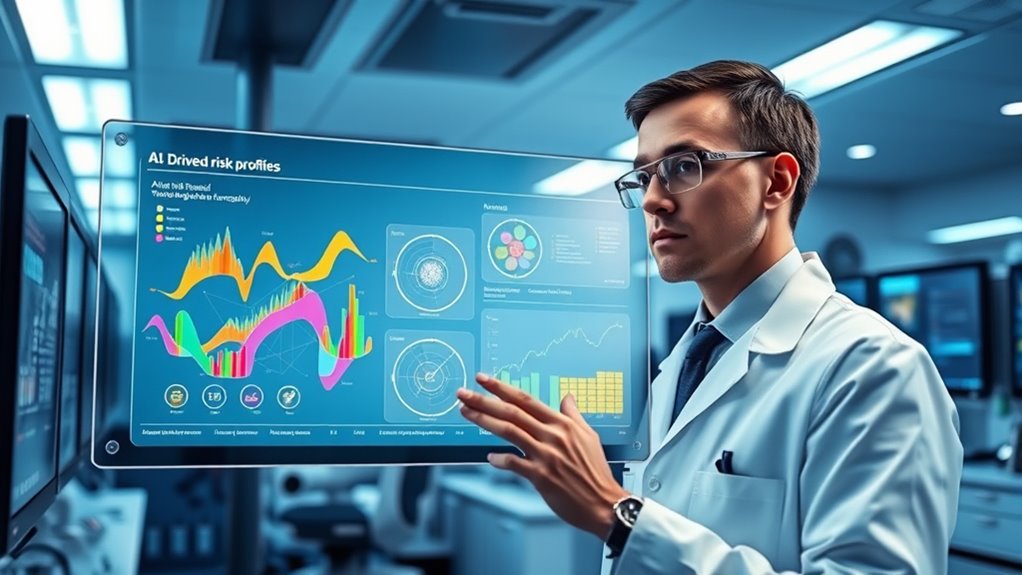Healthcare AI now predicts risk profiles for over 1,000 diseases with high accuracy, helping you and your doctors catch health issues early. These tools analyze complex health data, including genetics, lifestyle, and environment, to provide personalized insights. This proactive approach enables targeted interventions, reducing healthcare costs and improving outcomes. As this technology advances, you’ll see more transparent and tailored health strategies—stay tuned if you want to learn how this can benefit you directly.
Key Takeaways
- AI tools like RiskPath predict risks for over a thousand diseases with 85-99% accuracy.
- They analyze complex health data, including genetics, lifestyle, and environment, for personalized risk profiling.
- Integration into lab workflows enables early detection and targeted interventions for various illnesses.
- Continuous data from wearables and apps enhances dynamic risk assessments across multiple diseases.
- AI-driven insights support proactive healthcare, reducing costs and improving outcomes for diverse health conditions.

Have you ever wondered how artificial intelligence is transforming healthcare? Today, AI is revolutionizing how we predict, prevent, and manage diseases. Imagine tools that can identify your risk for over a thousand illnesses years before symptoms ever appear. That’s exactly what’s happening with AI-powered risk profiling. For instance, RiskPath, an open-source Explainable AI toolkit, can forecast the progression of chronic diseases long before they manifest clinically. It boasts an accuracy rate between 85% and 99%, far surpassing traditional models that typically range from 50% to 75%. What sets RiskPath apart is its ability to not only predict your risk but also explain how different factors—such as lifestyle, genetics, or environmental exposures—change over time, providing a clear picture of disease development. This transparency helps you and your healthcare providers understand why certain risks are elevated, fostering better decision-making. The integration of AI into healthcare systems is also improving the ability to analyze complex health data, leading to more precise diagnoses and interventions. Early detection is vital because over 90% of healthcare costs and mortality globally stem from chronic, progressive illnesses. By pinpointing risk factors early, AI enables targeted preventive strategies, shifting the focus from reactive treatment to proactive health management. AI models analyze vast amounts of data, including lab results, medical histories, and demographic information, to generate highly personalized risk scores. Companies like Siemens Healthineers have developed algorithms that seamlessly integrate into existing lab workflows, offering healthcare professionals early alerts for diseases like cancer, liver conditions, or COVID-19 severity. These AI tools analyze routine lab tests—used in over 70% of medical decisions—and turn them into early warning signals, often before physical symptoms arise. AI’s predictive capabilities extend beyond individual diagnoses. It can forecast risks at the population level, identifying groups more vulnerable to specific diseases or emergencies. This data-driven approach supports more precise classifications and tailored treatments, making healthcare more efficient and effective. Additionally, AI monitors online trends and misinformation, helping control the spread of sexually transmitted infections and other preventable diseases. Real-time AI recommendations assist clinicians in reducing errors and improving decision quality. AI’s synergy with precision medicine further enhances disease management. Large, validated datasets train models that deliver reliable risk predictions and treatment response insights. Wearables, mobile apps, and voice assistants now interface with AI to deliver personalized health advice “just-in-time,” encouraging healthier behaviors. This integration aims to lower the overall disease burden, reduce preventable costs, and improve outcomes. With explainable AI, individuals receive transparent, understandable insights into their health risks, fostering trust and engagement. Continuous health data from wearable devices feeds into these models, allowing dynamic risk assessments and timely interventions. Overall, AI is helping to make healthcare more predictive, preventive, and personalized—transforming how we understand and manage health risks across a broad spectrum of diseases. Furthermore, the use of AI in monitoring health can draw parallels to whole-house water filtration systems, ensuring that individuals receive consistent quality in both their health and environment.
Frequently Asked Questions
How Does AI Ensure Data Privacy in Healthcare Applications?
AI guarantees data privacy in healthcare by implementing multi-layered security, such as encryption and access controls. You’re protected through continuous AI model training, regular security audits, and monitoring access points to detect breaches early. Federated learning keeps data decentralized, while strict governance and transparent practices maintain trust. Compliance with regulations like HIPAA guides ethical data handling, and educating staff helps prevent insider threats, all working together to safeguard sensitive patient information.
Can AI Predict Rare Diseases With Limited Data?
You might be surprised to learn that AI models can predict rare diseases with about 63-69% accuracy, even with limited data. By analyzing scarce and fragmented datasets, AI detects subtle patterns through techniques like transfer learning and ensemble methods. These approaches help you identify complex cases early, reducing diagnostic delays. While challenges remain, AI’s ability to work with small data sets is improving, making rare disease prediction more feasible than ever.
What Are the Limitations of AI in Diagnosing Diseases?
You should know that AI faces several limitations in diagnosing diseases. It often struggles with biased data, leading to underperformance for marginalized groups. Privacy concerns and cybersecurity risks can compromise patient trust. Technical challenges include difficulty processing unstructured information and inconsistent performance across diseases. Additionally, high costs, liability issues, and the need for ongoing training hinder widespread adoption and reliable clinical outcomes, making AI less effective than you’d hope in some diagnostic scenarios.
How Is Patient Consent Managed With Ai-Driven Insights?
Imagine steering through a foggy landscape; you need a clear map to navigate. In AI-driven healthcare, you’re asked to sign a consent form that reveals how AI guides your care, explaining its role, risks, and benefits. Providers endeavor to make this understandable, balancing detail with simplicity. You can choose to opt out if AI’s involvement feels too opaque, ensuring your autonomy remains at the heart of your care journey.
What Training Is Required for Healthcare Professionals Using AI Tools?
You need thorough training in AI fundamentals, clinical integration, and technical skills to effectively use AI tools. This includes understanding how to operate AI systems, interpret their outputs, and assess their reliability. You should also develop critical appraisal skills, ethical awareness, and communication strategies for discussing AI insights with patients. Participating in specialized certification programs and staying updated on evolving AI technologies ensures you can confidently and responsibly incorporate AI into clinical practice.
Conclusion
Imagine a patient named Sarah, who’s at risk for diabetes but shows no symptoms. Thanks to healthcare AI, her risk profile is identified early, allowing her doctor to intervene and prevent a serious health crisis. This technology empowers you to catch diseases before they strike, saving lives and transforming healthcare. As AI continues to evolve, you’ll have the tools to make more proactive, personalized decisions—protecting your health and those you love.










